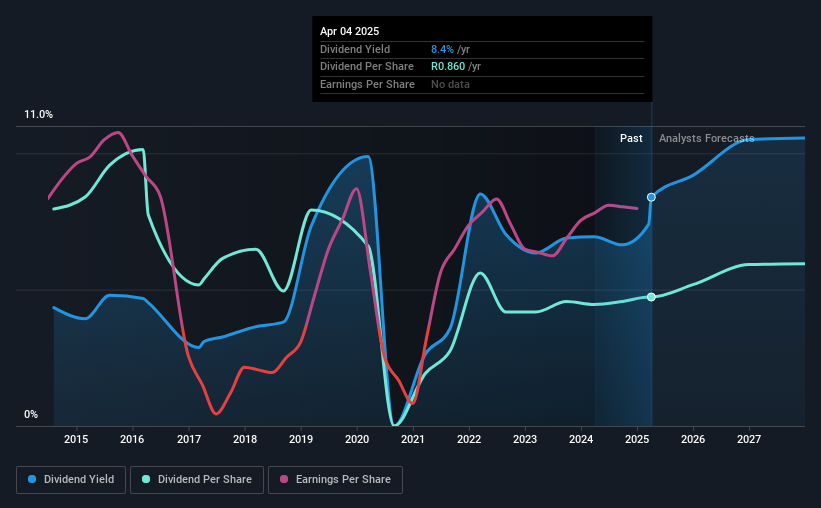
Readers hoping to buy Old Mutual Limited (JSE:OMU) for its dividend will need to make their move shortly, as the stock is about to trade ex-dividend. The ex-dividend date is two business days before a company's record date in most cases, which is the date on which the company determines which shareholders are entitled to receive a dividend. The ex-dividend date is of consequence because whenever a stock is bought or sold, the trade can take two business days or more to settle. This means that investors who purchase Old Mutual's shares on or after the 9th of April will not receive the dividend, which will be paid on the 14th of April.
The company's next dividend payment will be R00.52 per share, and in the last 12 months, the company paid a total of R0.86 per share. Based on the last year's worth of payments, Old Mutual has a trailing yield of 8.4% on the current stock price of R010.25. Dividends are a major contributor to investment returns for long term holders, but only if the dividend continues to be paid. As a result, readers should always check whether Old Mutual has been able to grow its dividends, or if the dividend might be cut.
Dividends are usually paid out of company profits, so if a company pays out more than it earned then its dividend is usually at greater risk of being cut. Old Mutual paid out a comfortable 49% of its profit last year.
Generally speaking, the lower a company's payout ratios, the more resilient its dividend usually is.
Check out our latest analysis for Old Mutual
Click here to see the company's payout ratio, plus analyst estimates of its future dividends.

Have Earnings And Dividends Been Growing?
Companies with falling earnings are riskier for dividend shareholders. Investors love dividends, so if earnings fall and the dividend is reduced, expect a stock to be sold off heavily at the same time. So we're not too excited that Old Mutual's earnings are down 2.7% a year over the past five years.
Another key way to measure a company's dividend prospects is by measuring its historical rate of dividend growth. Old Mutual's dividend payments per share have declined at 5.1% per year on average over the past 10 years, which is uninspiring. It's never nice to see earnings and dividends falling, but at least management has cut the dividend rather than potentially risk the company's health in an attempt to maintain it.
To Sum It Up
Should investors buy Old Mutual for the upcoming dividend? Old Mutual's earnings per share are down over the past five years, although it has the cushion of a low payout ratio, which would suggest a cut to the dividend is relatively unlikely. It might be worth researching if the company is reinvesting in growth projects that could grow earnings and dividends in the future, but for now we're on the fence about its dividend prospects.
However if you're still interested in Old Mutual as a potential investment, you should definitely consider some of the risks involved with Old Mutual. Case in point: We've spotted 1 warning sign for Old Mutual you should be aware of.
A common investing mistake is buying the first interesting stock you see. Here you can find a full list of high-yield dividend stocks.
New: AI Stock Screener & Alerts
Our new AI Stock Screener scans the market every day to uncover opportunities.
• Dividend Powerhouses (3%+ Yield)
• Undervalued Small Caps with Insider Buying
• High growth Tech and AI Companies
Or build your own from over 50 metrics.
Have feedback on this article? Concerned about the content? Get in touch with us directly. Alternatively, email editorial-team (at) simplywallst.com.
This article by Simply Wall St is general in nature. We provide commentary based on historical data and analyst forecasts only using an unbiased methodology and our articles are not intended to be financial advice. It does not constitute a recommendation to buy or sell any stock, and does not take account of your objectives, or your financial situation. We aim to bring you long-term focused analysis driven by fundamental data. Note that our analysis may not factor in the latest price-sensitive company announcements or qualitative material. Simply Wall St has no position in any stocks mentioned.
About JSE:OMU
Old Mutual
Provides financial services primarily in South Africa and rest of Africa.
Fair value with acceptable track record.
Similar Companies
Market Insights
Community Narratives




